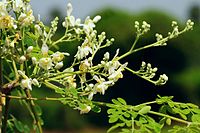
Photo from wikipedia
In this work a comparative study on phytochemical profiles of comfrey root extracts obtained by different extraction approaches has been carried out. Chemical profiles of extracts obtained by supercritical fluid… Click to show full abstract
In this work a comparative study on phytochemical profiles of comfrey root extracts obtained by different extraction approaches has been carried out. Chemical profiles of extracts obtained by supercritical fluid (SFE), pressurized liquid (PLE), and conventional solid/liquid extraction were compared and discussed. Phytochemical composition was assessed by high-performance liquid chromatography coupled with electrospray time-of-flight mass spectrometry (HPLC-ESI-QTOF-MS/MS) identifying 39 compounds reported for the first time in comfrey root, mainly phenolic acids and fatty acids. The influence of different extraction parameters on phytochemical profiles of S. officinale root was investigated for all applied techniques. PLE and maceration, using alcohol-based solvents (aqueous methanol or ethanol), were shown to be more efficient in the recovery of more polar compounds. Greater numbers of phenolics were best extracted by PLE using 85% EtOH at 63 °C. The use of SFE and 100% acetone for 30 min enabled good recoveries of nonpolar compounds. SFE using 15% EtOH as a cosolvent at 150 bar produced the best recoveries of a significant number of fatty acids. The main compositional differences between extracts obtained by different extraction techniques were assigned to the solvent type. Hence, these results provided comprehensive approaches for treating comfrey root enriched in different phytochemicals, thereby enhancing its bioaccessibility.
Journal Title: Molecules
Year Published: 2020
Link to full text (if available)
Share on Social Media: Sign Up to like & get
recommendations!